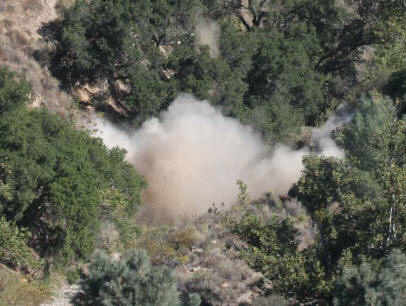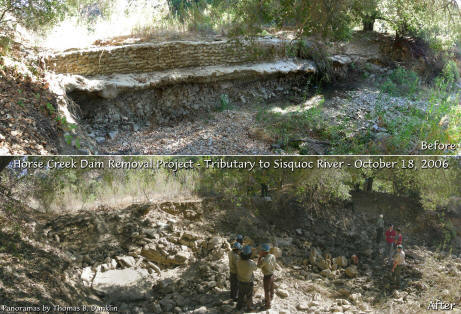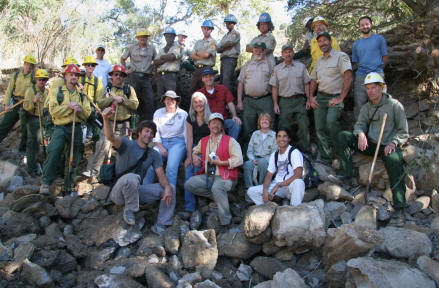|
October 18, 2006
DEFUNCT DAM DEMOLISHED IN
SISQUOC RIVER WATERSHED
Dam Removal
Opens Up More Than Five Miles of Historic Habitat for Endangered
Steelhead in Horse Creek,
San Rafael Wilderness
Horse
Canyon, Calif. - Using more than forty sticks of dynamite, a
team of experts demolished a dam today on Horse Creek, a
tributary to the Sisquoc Wild & Scenic River in the San Rafael
Wilderness of the Los Padres National Forest. The project opens
up five miles of critical habitat for endangered steelhead that
has been blocked for nearly forty years.

A cloud of dust signals the
detonation of Horse Canyon Dam.
The Horse Canyon Dam was built following the Wellman fire in
the mid-1960s by the Santa Barbara County Flood Control
Department. The fire burned the upper reaches of this watershed,
and the dam was built to prevent erosion and debris from flowing
into the Sisquoc River. However, the area behind the dam quickly
became filled with sediment and by 1969, it no longer served its
intended purpose.
Horse Creek
historically served as spawning and rearing habitat for one of
the southernmost populations of southern steelhead, an
endangered fish that has become so rare that it is now protected
under federal law. With a crest of nearly 9 feet above the
downstream channel bed, the dam became too tall for steelhead to
jump, and completely blocks them from migrating upstream.

Looking north towards Horse Canyon
from the Sisquoc River.
A report in 2003 by Stoecker Ecological identified the dam as
a barrier to steelhead migration, and a subsequent management
plan for the Sisquoc Wild & Scenic River recommended removal of
the dam as a way to restore the outstandingly remarkable values
of this river system.
Today's "damolition"
will eventually allow unobstructed migration of steelhead to the
entire Horse Creek drainage and access to more than five miles
of upstream habitat. Experts also hope that the removal of the
dam will restore natural watershed functions and prevent
downstream bank erosion and scour caused by the dam.
A California
Department of Fish & Game blasting crew spent yesterday
preparing the site for demolition, drilling the equivalent of
more than forty sticks of dynamite into the dam. The crew was
supported by a team of biological experts, firefighters, and
California Conservation Corps.
On the day
before the blast, biologists surveyed the area for the presence
of rare plants and animals. Work crews carried all equipment
onto the blast site from nearby private lands, and did an
excellent job of removing all of the rebar that was exposed
after the detonation.
The
explosion broke the dam into small pieces. Winter streamflows
will carry the rubble and sediment downstream, eventually
restoring the area to its natural condition. Biologists will
monitor the area over the next few years to record how the
stream channel returns to its natural condition, and how many
steelhead return to the area.

BEFORE & AFTER
Removal of the Horse Creek dam was a cooperative effort
involving the DFG, Pacific States Marine Fisheries Commission,
CCC, Community Environmental Council, and Stoecker Ecological
Consulting. The project was funded by the Forest Service,
Department of Fish & Game, American Rivers, and National Oceanic
and Atmospheric Administration. ForestWatch supported the
project and accompanied the crew on-site on the day of the
blast.

The crew celebrates atop the
rubble that was once Horse Canyon Dam.
|

